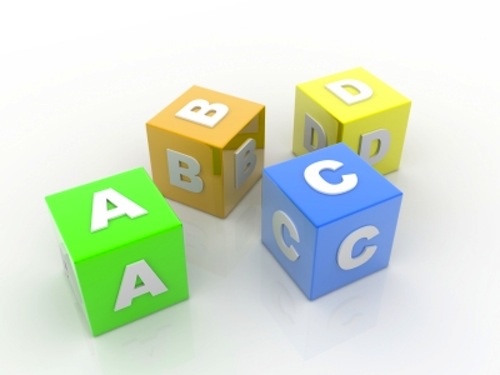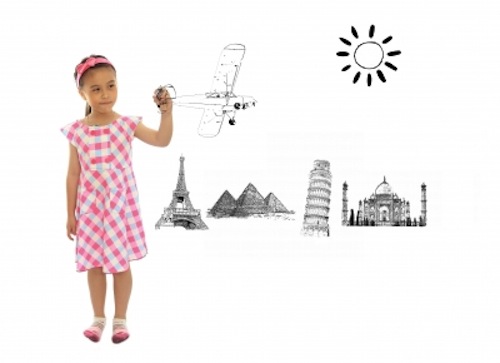7 Ways to Promote Early Education
 It’s never too early to start actively enforcing your toddler’s learning, even before they head to preschool. Simple, every day activities promote early education, putting your child in peak learning shape for when they do head to school.
It’s never too early to start actively enforcing your toddler’s learning, even before they head to preschool. Simple, every day activities promote early education, putting your child in peak learning shape for when they do head to school.
Stick to a routine. Consistency is grounding and gives children a sense of trust. Once their environment is stable, they’ll be more open to learning, especially at an early age.
Hit the books early. Just because your child can’t read on their own quite yet, doesn’t mean they don’t love to read. Reading out loud can help jumpstart reading skills. Plus, reading to your little one helps build basic skills like speech, sentence structure and the abcs of learning (like reading from left to right).
Let them help with every day tasks. There are measuring lessons in cooking, color recognition in laundry and biology lessons in gardening. Learning every day tasks will not only teach responsibility and the jobs themselves, but there are mini lessons to be learned with each activity.
Participate. Joining in and guiding result in more effective learning than simply telling children what to do. Kids learn by example and, especially at young ages, often mirror their parents and teachers. They’ll learn faster if they have someone to observe and copy.
Communicate. Simply talking and listening to your child will help them learn. They want to both ask you questions and share their theories and experiences. Listen when they do and actively respond. If your child is telling you about coloring at a play date, ask what they drew and why they chose that subject. Talk about their favorite colors.
Encourage creativity. Youngsters learn by imagining and imitating through dress up and pretending. Encourage them to express themselves and make believe. These behaviors are their way of understanding and digesting the world around them.
Time and patience are key. Take things slow and one day at a time. Just like adults, children have good and bad days. It’s your job to remain consistent and loving, not frustrated. Plus, overstimulation is never good. A slow, steady pace gives your little one time to digest all of the new information they’re taking in.
Sources:
-Serge, Irene. “Time to Get Serious About Early Learning.” Eye on Early education. November 28, 2012. < http://eyeonearlyeducation.org/2012/11/28/time-to-get-serious-about-early-learning/>
-“10 Reasons Why You Should Read to Your Kids” Early Moments. < http://www.earlymoments.com/Promoting-Literacy-and-a-Love-of-Reading/Why-Reading-to-Children-is-Important/>
-“Promoting Learning.” BornLearning.org. http://www.bornlearning.org/default.aspx?id=17
-“Early Learning at Home and in Preschool.” 4Children.org. http://www.4children.org/issues/2012/spring/early_learning_at_home_and_in_preschool/
-Photo courtesy of sheelamohan/freedigitalphotos.net
10 Ways to Increase Brain Development in Babies
Baby brains develop at a rapid rate. Infants’ neurological wiring holds a world of opportunities. Key development begins at an incredibly early age and stimulating your child’s mind could end up boosting their brainpower and shaping his or her intelligence for years to come. Here are 10 ways to help grow your baby’s intellect:
1. Grow a healthy brain before your baby’s born.
Staying as healthy as possible during pregnancy will give your baby-to-be the best shot at a healthy mind. Maintain a well-balanced diet, exercise, get plenty of sleep and schedule regular doctor appointments. Avoid medications that are known to harm fetal development because often, the brain is the first body part harmed.
2. Pay attention to your little one.
Children have a much higher chance of learning when their curiosity and observations are rewarded. Follow their gaze and comment on what they’re looking at, respond to pointing and describe what the two of you are checking out.
3. Converse with your baby.
Talk to your baby, even if he or she isn’t talking back just yet. Respond to baby talk and describe whatever you’re doing, whether it’s talking about making dinner or changing a diaper. This is how babies learn vocabulary and basic sentence structure.
4. Read to your little one.
Sparking an early interest in books and literature is essential to teaching language. Pick out books with large, colorful illustrations and simple story lines.
5. If your toddler is old enough to play, he or she is old enough to help clean up.
Enforcing cleanup early on introduces important concepts like responsibility and the idea of consequence. But remember, your toddler doesn’t know that cleaning up is a chore yet so make it fun! Sing a cleanup song while you work. Toddlers are eager to help and want to please so make a game out of cleaning up and always remember to thank your little helper.
6. Don’t shy away from a mess.
Scooping mud, splashing water and digging in sand is how little ones explore basic physics. Even though these messy ideas may seem like your worst nightmare, they’re essential for spiking your child’s curiosity and learning. Avoid disaster by making messy play extra structured and keep it outside. Then, when it’s cleanup time, head to the bathtub where your toddler can explore even more textures like slimy soap and a squishy sponge.
7. Allow for crawl space.
Many parents have a hard time letting their newly crawling babies run loose, but this is an important part of their development. Set up a safe, baby-proofed area, free of little objects and blocked off from stairs and sharp corners. Then let your baby run (or crawl) wild. This is how they can investigate the world around them and start to familiarize themselves with day-to-day objects.
8. Sing songs.
Songs are a fun way to learn. Children’s songs teach everything from the alphabet to animals to shapes and colors. They’re also a great way to pass times that may otherwise be boring for a little one. So next time you’re stuck in traffic, bust out your new secret weapon: the Itsy Bitsy Spider.
9. Use every opportunity to learn.
Sometimes parents forget that necessities, like meals or bath time, can be great learning opportunities to explore daily activities. So when you sit down to feed your baby, describe what he or she is eating. Is it fruit, a vegetable or something else? What’s it called? What color is it? Babies will begin to develop favorite tastes and learn to request them by name.
10. Remain positive whenever possible.
No matter how crabby, sleep-deprived and frustrated you get, try your hardest to remain positive. State rules clearly and, by all means, punish if you need to, but always try to reward good behavior. Often times, rewarding the good stuff will save you from having to punish the bad stuff later on.
Sources:
-“20 Ways to Boost Your Baby’s Brain Power.” Scholastic.
-Photo courtesy of Stuart Miles/freedigitalphotos.net
Top Educational Books for Tots
Counting books
There’s a whole list of books out there that help kids learn their numbers.
- 1, 2, 3 to the Zoo by Eric Carle explores the magic of numbers as different animals pile on the train to head to the zoo. This story is meant for kids 2-4 years old.
- Counting Kisses by Karen Katz is a cute counting book for kids ages 0-4.
- How Do Dinosaurs Count to 10? by Jane Yolen, for kids 4-7 years old, uses rhymes to help teach readers how to count to 10.
- In David Kirk’s Miss Spider’s Tea Party, for 4-6 year-olds, Miss Spider attempts to squash her neighbors’ fear of her by throwing a tea party.
ABC books
ABC books like these teach children letter recognition:
- Pam Abrams’ Now I Eat My ABCs for tots 0-3 has a yummy food assigned to each letter of the alphabet. B is made of blueberries and O is an orange.
- I Spy Letters by Jean Marzolo lets 0-4 year-olds learn letters through rhyming and hand-painted letters.
- The classic Chicka Chicka Boom Boom by Bill Martin Jr. and John Archambault tells the story of a, b, c, d and e meeting at the top of a coconut tree.
Colors
Teach your little ones colors:
- Justine Smith’s Colors is filled with bright, bolds illustrations. This book is made for children 1-3.
- A kitten hunts for its favorite color in Cat’s Colors by Jane Cabrera.”Favorite
Shapes
Help toddlers learn their shapes:
- Every day objects in Justine Smith’s Shapes help kids 0-2 learn shapes. Plus, the rhyming words and colorful illustrations make learning fun.
Sources:
-“Educational Books for Toddlers.” Scholastic. http://www.scholastic.com/resources/article/educational-books-for-toddlers/
-“Favorite Books for Preschoolers.” Great Schools <http://www.greatschools.org/cgi-bin/showarticle/3607/>
-Photo courtesy of Stuart Miles/freedigitalphotos.net
Sign Language for Babies
Recently, more and more parents have been teaching their little ones sign language, many before they can even speak. The idea is that babies have the cognitive ability to comprehend language, but lack the physical ability to make the sounds. They can, however, learn sign language because the ability to make hand motions comes before the ability to easily form words.
Many experts even believe the benefits of learning sign language go farther than communication. Some have found that use of signing as a baby leads to confidence and higher self-esteem later in life. Signing also rewards eye contact, an important component of socializing that they’ll master in their later years.
Take the time for a short class, research online or pick up a book on simple sign language. Then start signing to your baby when you speak to him or her. As early or six or seven months, little ones can start using those signs to communicate with you.
Manners
“Please” and “thank you” are easy signs to learn, but they’ll help instill manners from the very beginning, making them a habit and giving you the most polite baby around!
Food
Teach your baby his or her favorite foods. Signs for “milk” “peas” and “applesauce” could save you a spit up mouthful of mushed up carrots. Plus, the simple signs for “food” and “water” help your baby tell you when he or she is hungry or thirsty.
Useful words
Signs for “more” and “done” can be more useful than imaginable. Babies often throw tantrums to show frustration and what’s more frustrating than being unable to communicate? Save yourself a scene by teaching your little one how to ask for more or tell you they’re finished.
Sources:
-“Baby sign language: top ten starter signs.” Baby Sign Language
-“Teaching your baby sign language can benefit both of you.” Psych Central
-Photo courtesy of photostock/freedigitalphotos.net
Raising Bilingual Children
The percent of children who speak a language other than English at home has risen from 10% to 21% in the past three decades, according to the National Center for Education Statistics. The amount of bilingual kids is on the rise and, while it’s actually been proven that older children may have an advantage when learning a second language, it never hurts to begin early. Starting off with more than one language as a baby will not slow progress of language in any way and will only advance memorization and problem solving skills. Here are some helpful tips for raising bilingual children:
Learn with them.
If you don’t already speak the second language you’re introducing to your child, this is your opportunity to learn too. They better you understand what you expect your little one to learn, the more thorough job you can do teaching them.
Start small.
Don’t feel like you need to be a pro and start speaking half in English and half in the chosen language. Start by throwing in a couple bedtime books in Spanish. Or sing simple, children’s French songs in the car. Adding small splashes of the secondary language will help teach your toddler basic vocabulary and concepts, the first start to raising a bilingual child.
Hire bilingual help.
Need a babysitter or nanny? Consider hiring one who speaks a second language and request that they communicate with your kids using that language at least 50% of the time. This is a great approach because it incorporates handy, everyday activities with the new vocabulary, making it easier to learn the familiar actions.
Take a vacation.
If affordable, travel to a country that speaks the language your child is learning. This is an especially great option as children get older and learn social skills. It will give them the opportunity to use their new language while making new friends.
Sources:
-Lowry, Lauren. “Bilingualism in Young Children: Separating Fact from Fiction.” The Hanen Center.
-“Raising bilingual kids: benefits and techniques.” PHD in Parenting.
-“ Fast Facts: English Language Learners.” National Center for Education Statistics.
-Paturel, Amy. “A Guide to Raising Bilingual Children.” Parenting.com
-Photo courtesy of Phaitoon/freedigitalphotos.net
Motor Skill Milestones
From only a few months old, babies will begin to develop motor skills. At first they’ll grab and giggle, but soon, they’ll begin to move their entire bodies.
Remember that each baby develops at his or her own pace so don’t panic if your child varies. However, if this is an ongoing trend you should ask your pediatrician about it just in case there are developmental delays.
Here are some key motor skill milestones to prepare for:
Rolling over
Around the same time that your baby is learning to sit on his or her own, they’ll learn to roll over. You’ll start to see your baby lift head and shoulders high, using arms in what looks like imitation pushups. Eventually, at as early as four months, your little one may be able to roll over from belly to back. But don’t worry if it takes another month or two to reverse the motion.
Crawling
Crawling typically starts to take place between six and 10 months. Likely signs that crawling is coming is if your baby starts repositioning his or herself from sitting up to hands and knees. You also may see some scooting, a sign of attempted movement. At first, babies may use the right leg and arm at the same time, but they’ll quickly learn that using the left arm with the right leg is much steadier and more efficient. Crawling gives babies an opportunity to explore the world around them.
Standing
After babies master crawling, they will begin to stand, not on their own at first, but while holding onto you or other objects for support. Babies are normally proficient standers by around nine months. Standing is an exciting sign because it’s the first step to walking.
Walking
Arguably one of the most exciting motor skill milestones, walking typically begins by holding onto objects and inching along. Most babies begin to walk on their own at around one year, but don’t begin to use more finely tuned motor skills, like walking backwards, until around 15 months.
Sources:
-“Developmental milestones: Rolling over.” Baby Center.
-“Baby physical and motor skills.” Baby Zone.
-“Baby Milestones.” Parenting.com.
-“Developmental milestones: Crawling.” Baby Center.
-“Milestone chart: 7-12 months.” Baby Center.
-Photo courtesy of photostock/freedigitalphotos.net
Do Early Preschool Programs Start Kids Too Young?
How early is too early to start your child in a school-based program? Can a two-year-old really gain anything from an early learning program? Are these programs really just daycares in disguise? These are all questions that may run through your mind when considering if you should enroll your child in an early preschool program, sometimes referred to as “Two’s programs.”
Don’t worry! Enrolling your two-year-old in an early learning program is neither too strict nor silly. Some benefits of early childhood education include:
-Improved social skills
-Practice interacting with adults
-Early intervention and the opportunity to spot any developmental delays
Here are some tips on what to look for if you decide to enroll your child in an early preschool program:
-Read reviews to get an idea of what’s available
-Visit the school to get a feel for the early program.
-Meet with the teacher and ask them about experience, background, and daily activities.
-Look for smaller group sizes. This is important, especially for little ones just starting out who aren’t used to learning in big group settings yet.
-Make sure the program offers plenty of communication through conferences, phone calls and any other form. This is an opportunity to learn about your child’s strengths, weaknesses and interests.
Sources:
-“What are the Benefits of Early Childhood Education?” LiveStrong
-“Early Preschool: Too Young for School?” Parenting.com
-Photo courtesy of Stuart Miles/freedigitalphotos.net


















